Cover������������
Title Page�����������������
Copyright����������������
Contents���������������
Preface
About the Author�����������������������
Chapter 1 Difference Equations�������������������������������������
Introduction�������������������
1 Time-Series Models���������������������������
2 Difference Equations and Their Solutions�������������������������������������������������
3 Solution by Iteration������������������������������
Iteration without an Initial Condition
Reconciling the Two Iterative Methods
Nonconvergent Sequences
4 An Alternative Solution Methodology��������������������������������������������
The Solution Methodology
Generalizing the Method
5 The Cobweb Model�������������������������
6 Solving Homogeneous Difference Equations�������������������������������������������������
Stability Conditions
Higher Order Systems
7 Particular Solutions for Deterministic Processes���������������������������������������������������������
8 The Method of Undetermined Coefficients������������������������������������������������
Higher Order Systems
A Solved Problem
9 Lag Operators����������������������
Lag Operators in Higher Order Systems
10 Summary�����������������
Questions and Exercises������������������������������
Chapter 2 Stationary Time-Series Models����������������������������������������������
1 Stochastic Difference Equation Models����������������������������������������������
2 ARMA Models��������������������
3 Stationarity���������������������
Stationarity Restrictions for an AR(1) Process
4 Stationarity Restrictions for an ARMA (p, q) Model�����������������������������������������������������������
Stationarity Restrictions for the Autoregressive Coefficients
5 The Autocorrelation Function�������������������������������������
The Autocorrelation Function of an AR(2) Process
The Autocorrelation Function of an MA(1) Process
The Autocorrelation Function of an ARMA(1,1) Process
6 The Partial Autocorrelation Function���������������������������������������������
7 Sample Autocorrelations of Stationary Series�����������������������������������������������������
Model Selection Criteria
Estimation of an AR(1) Model
Estimation of an ARMA(1, 1) Model
Estimation of an AR(2) Model
8 Box-Jenkins Model Selection������������������������������������
Parsimony
Stationarity and Invertibility
Goodness of Fit
Postestimation Evaluation
9 Properties of Forecasts��������������������������������
Higher-Order Models
Forecast Evaluation
10 A Model of the Interest Rate Spread���������������������������������������������
Out-of-Sample Forecasts
11 Seasonality���������������������
Models of Seasonal Data
Seasonal Differencing
12 Parameter Instability and Structural Change�����������������������������������������������������
Testing for Structural Change
Endogenous Breaks
Parameter Instability
An Example of a Break
13 Combining Forecasts�����������������������������
Optimal Weights
Example Using the Spread
14 Summary and Conclusions���������������������������������
Questions and Exercises������������������������������
Chapter 3 Modeling Volatility������������������������������������
1 Economic Time Series: The Stylized Facts�������������������������������������������������
2 ARCH and GARCH Processes���������������������������������
ARCH Processes
The GARCH Model
3 ARCH and GARCH Estimates of Inflation����������������������������������������������
Engle’s Model of U.K. Inflation
Bollerslev’s Estimates of U.S. Inflation
4 Three Examples of GARCH Models���������������������������������������
A GARCH Model of Oil Prices
Volatility Moderation
A GARCH Model of the Spread
Formal Tests for ARCH Errors
Alternative Estimates of the Model
5 A GARCH Model of Risk������������������������������
6 The ARCH-M Model�������������������������
Implementation
7 Additional Properties of GARCH Processes�������������������������������������������������
Properties of GARCH(1, 1) Error Processes
Assessing the Fit
Diagnostic Checks for Model Adequacy
Forecasting the Conditional Variance
8 Maximum Likelihood Estimation of GARCH Models������������������������������������������������������
9 Other Models of Conditional Variance���������������������������������������������
The IGARCH Model
Models with Explanatory Variables
Models with Asymmetry: TARCH and EGARCH
Testing for Leverage Effects
Nonnormal Errors
10 Estimating the NYSE U.S. 100 Index��������������������������������������������
The Model of the Mean
Testing for GARCH errors
Alternative Estimates of the Model
Diagnostic Checking
The Asymmetric Models
11 Multivariate GARCH����������������������������
Updating the Study
12 Volatility Impulse Responses��������������������������������������
An Example
13 Summary and Conclusions���������������������������������
Questions and Exercises������������������������������
Chapter 4 Models with Trend����������������������������������
1 Deterministic and Stochastic Trends��������������������������������������������
The Random Walk Model
The Random Walk Plus Drift Model
Generalizations of the Stochastic Trend Model
2 Removing the Trend���������������������������
Differencing
Detrending
Difference versus Trend Stationary Models
Are There Business Cycles?
The Trend in Real GDP
3 Unit Roots and Regression Residuals��������������������������������������������
4 The Monte Carlo Method�������������������������������
Monte Carlo Experiments
Example of the Monte Carlo Method
Generating the Dickey–Fuller Distribution
5 Dickey-Fuller Tests����������������������������
An Example
6 Examples of the Dickey-Fuller Test�������������������������������������������
Quarterly Real U.S. GDP
Unit Roots and Purchasing Power Parity
7 Extensions of the Dickey-Fuller Test���������������������������������������������
Selection of the Lag Length
The Test with MA Components
Multiple Roots
Seasonal Unit Roots
8 Structural Change��������������������������
Perron’s Test for Structural Change
Perron’s Test and Real Output
Tests with Simulated Data
9 Power and the Deterministic Regressors�����������������������������������������������
Power
Determination of the Deterministic Regressors
10 Tests with More Power�������������������������������
An Example
11 Panel Unit Root Tests�������������������������������
Limitations of the Panel Unit Root Test
12 Trends and Univariate Decompositions����������������������������������������������
The General ARIMA(p, 1,q) Model
The Hodrick–Prescott Decomposition
13 Summary and Conclusions���������������������������������
Questions and Exercises������������������������������
Chapter 5 Multiequation Time-Series Models�������������������������������������������������
1 Intervention Analysis������������������������������
Estimating the Effect of Metal Detectors on Skyjackings
Estimating the Effect of the Libyan Bombing
2 ADLs and Transfer Functions������������������������������������
ADL Models
The Cross-Covariances of a Second-Order Process
Higher-Order Input Processes
Identification and Estimation
3 An ADL of Terrorism in Italy�������������������������������������
4 Limits to Structural Multivariate Estimation�����������������������������������������������������
Multivariate Macroeconometric Models: Some Historical Background
5 Introduction to VAR Analysis�������������������������������������
Stability and Stationarity
Dynamics of a VAR Model
6 Estimation and Identification��������������������������������������
Forecasting
Identification
7 The Impulse Response Function��������������������������������������
Confidence Intervals and Impulse Responses
Variance Decomposition
8 Testing Hypotheses���������������������������
Granger Causality
Granger Causality and Money Supply Changes
9 Example of a Simple VAR: Domestic and Transnational Terrorism����������������������������������������������������������������������
Empirical Methodology
Empirical Results
10 Structural VARs�������������������������
Structural Decompositions
11 Examples of Structural Decompositions�����������������������������������������������
12 Overidentified Systems��������������������������������
Two Examples
13 The Blanchard-Quah Decomposition������������������������������������������
The Blanchard and Quah Results
14 Decomposing Real and Nominal Exchange Rates: An Example�����������������������������������������������������������������
Limitations of the Technique
15 Summary and Conclusions���������������������������������
Questions and Exercises������������������������������
Chapter 6 Cointegration and Error-Correction Models����������������������������������������������������������
1 Linear Combinations of Integrated Variables����������������������������������������������������
2 Cointegration and Common Trends����������������������������������������
3 Cointegration and Error Correction�������������������������������������������
The n-Variable Case
4 Testing for Cointegration: The Engle-Granger Methodology�����������������������������������������������������������������
5 Illustrating the Engle-Granger Methodology���������������������������������������������������
The Engle–Granger Procedure with I(2) Variables
6 Cointegration and Purchasing Power Parity��������������������������������������������������
7 Characteristic Roots, Rank, and Cointegration������������������������������������������������������
8 Hypothesis Testing���������������������������
Lag Length and Causality Tests
To Difference or Not to Difference
Tests on Multiple Cointegrating Vectors
The Test in the Presence of I(2) Variables
9 Illustrating the Johansen Methodology����������������������������������������������
10 Error-Correction and ADL Tests����������������������������������������
Cointegration with Weak Exogeneity
Inference on the Cointegrating Vector
11 Comparing the Three Methods�������������������������������������
The Engle–Granger Methodology
The Johansen Methodology
The Error-Correction Methodology
12 Summary and Conclusions���������������������������������
Questions and Exercises������������������������������
Chapter 7 Nonlinear Models and Breaks��������������������������������������������
1 Linear Versus Nonlinear Adjustment�������������������������������������������
2 Simple Extensions of the ARMA Model��������������������������������������������
The GAR Model
The Bilinear Model
An Example
3 Testing for Nonlinearity���������������������������������
The ACF and the McLeod–Li Test
The RESET
Other Portmanteau Tests
Lagrange Multiplier Tests
Two Examples
Inference with Unidentified Nuisance Parameters
4 Threshold Autoregressive Models����������������������������������������
The Basic Threshold Model
Estimation
Unknown Threshold
5 Extensions of the TAR Model������������������������������������
Selecting the Delay Parameter
Multiple Regimes
More on Estimating the Threshold
Threshold Regression Models
Pretesting for a TAR Model
TAR Models and Endogenous Breaks
6 Three Threshold Models�������������������������������
The Unemployment Rate
Asymmetric Monetary Policy
Capital Stock Adjustment with Multiple Thresholds
7 Smooth Transition Models���������������������������������
Pretests for STAR Models
8 Other Regime Switching Models��������������������������������������
The Artificial Neural Network
The Markov Switching Model
9 Estimates of STAR Models���������������������������������
An LSTAR Model
The Real Exchange Rate as an ESTAR Process
10 Generalized Impulse Responses and Forecasting�������������������������������������������������������
Nonlinear Estimates of GNP Growth
Impulse Responses
Terrorist Incidents with Casualties
11 Unit Roots and Nonlinearity�������������������������������������
An Example
12 More on Endogenous Structural Breaks����������������������������������������������
Two Examples
Nonlinear Breaks
Estimates of a Logistic Break
13 Summary and Conclusions���������������������������������
Questions and Exercises������������������������������
Index������������
EULA
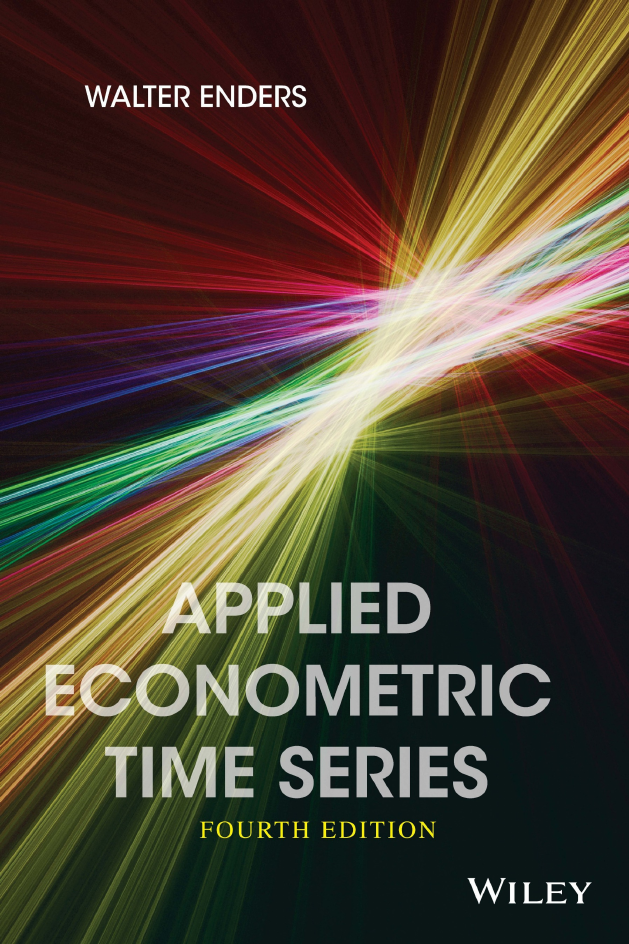

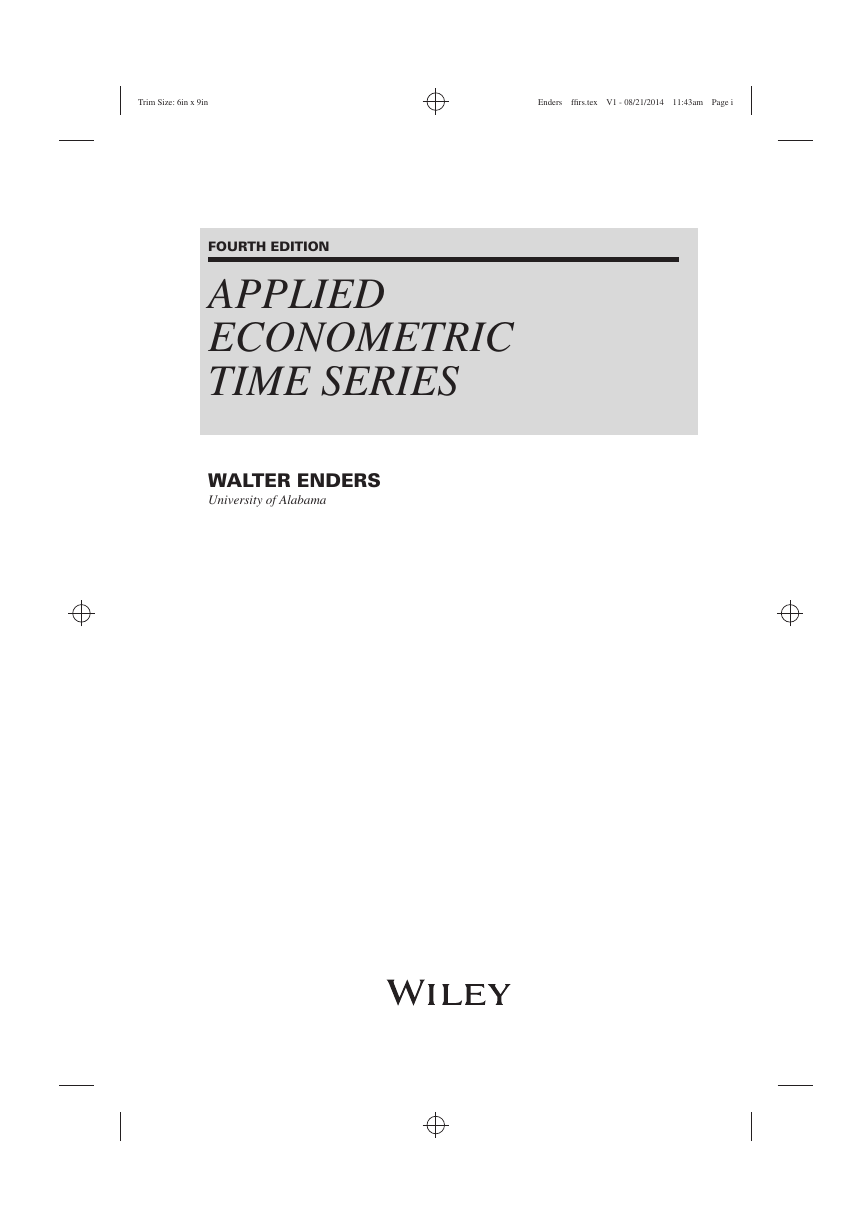
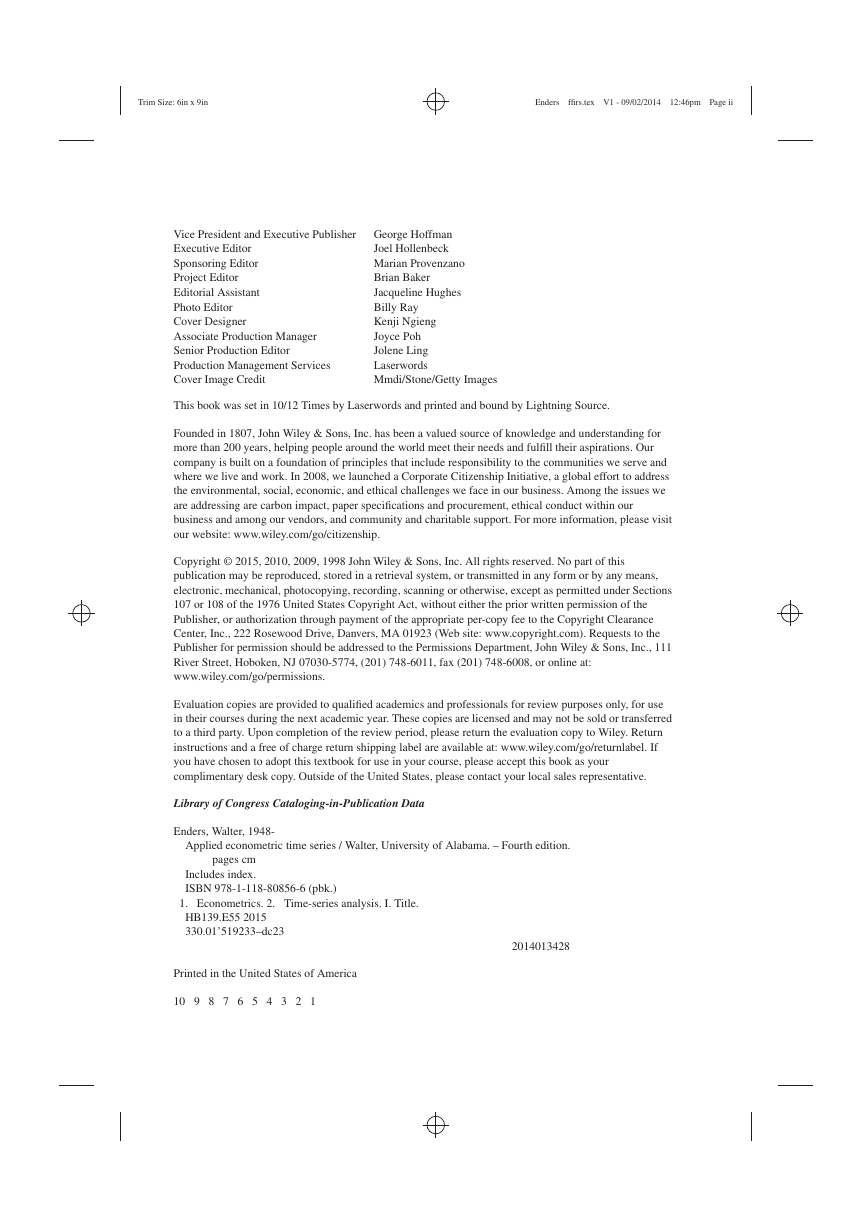

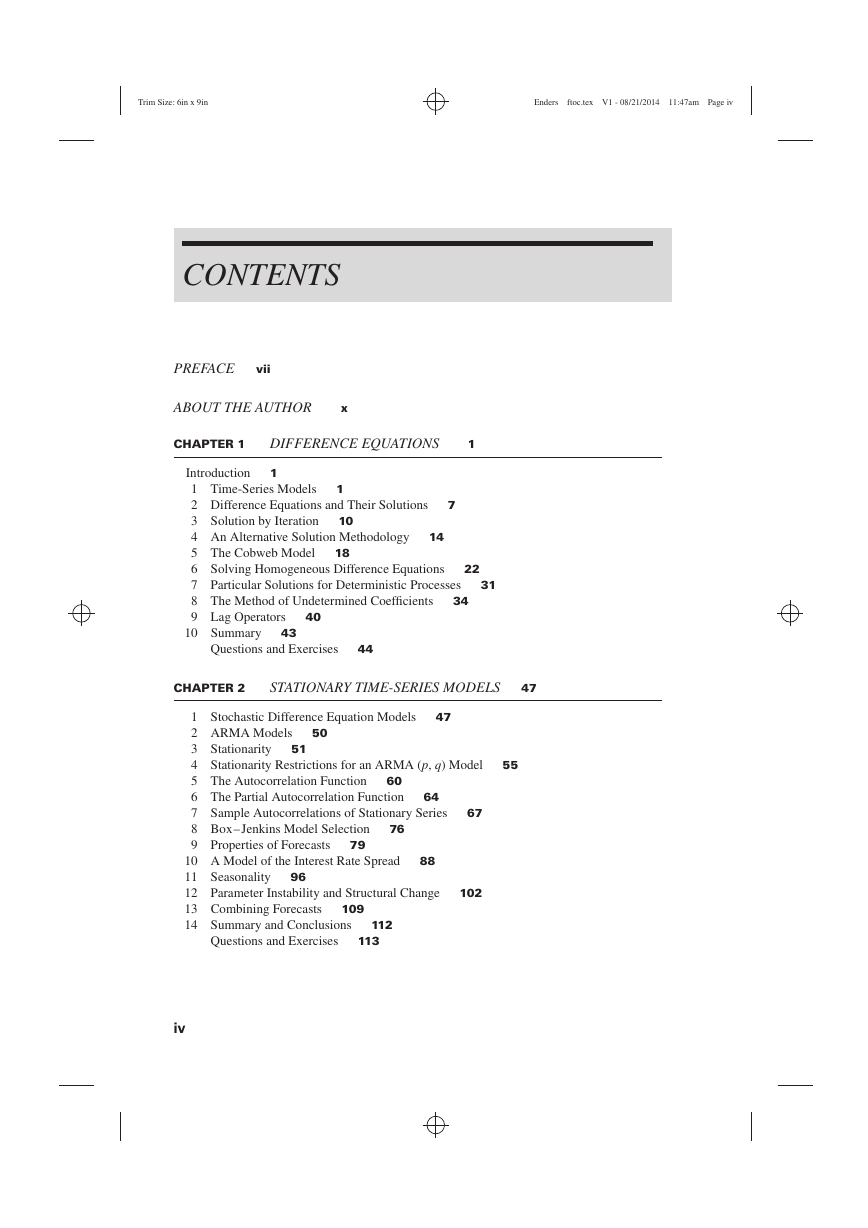
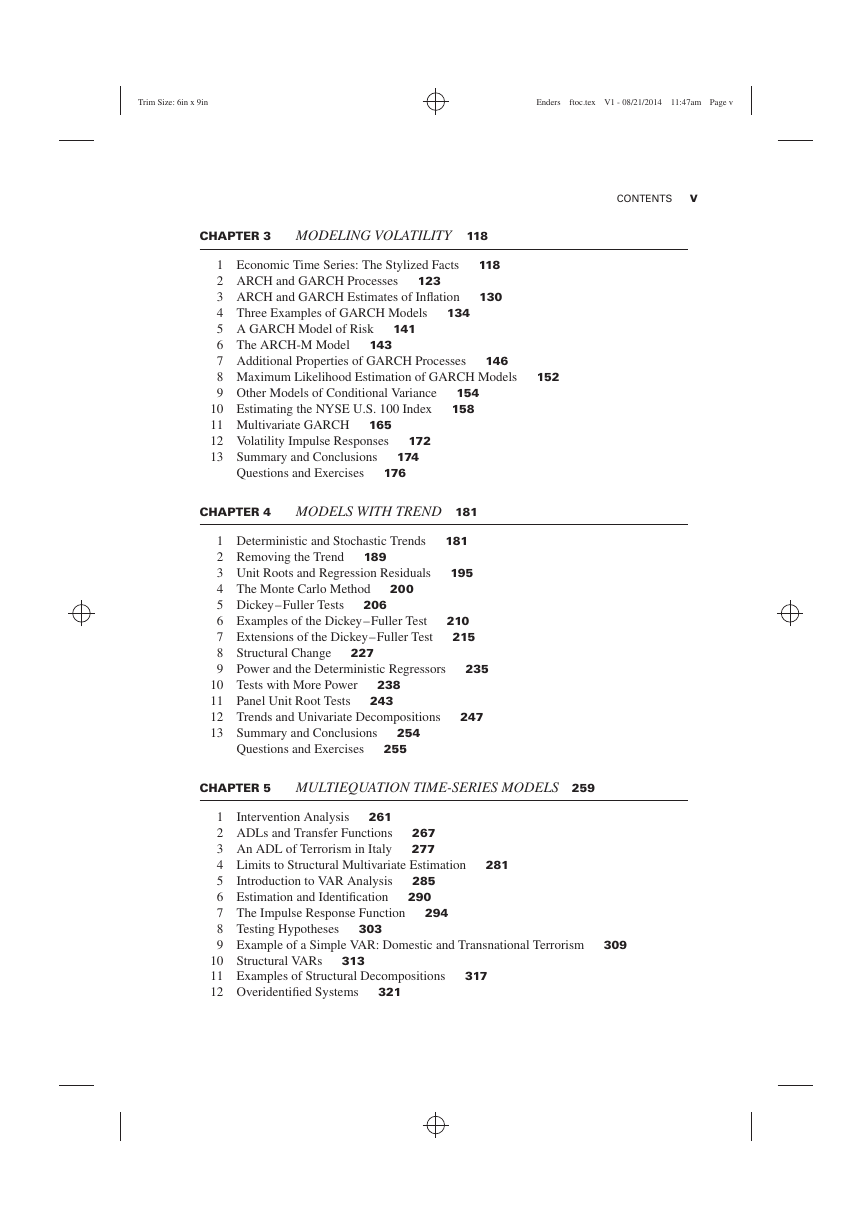
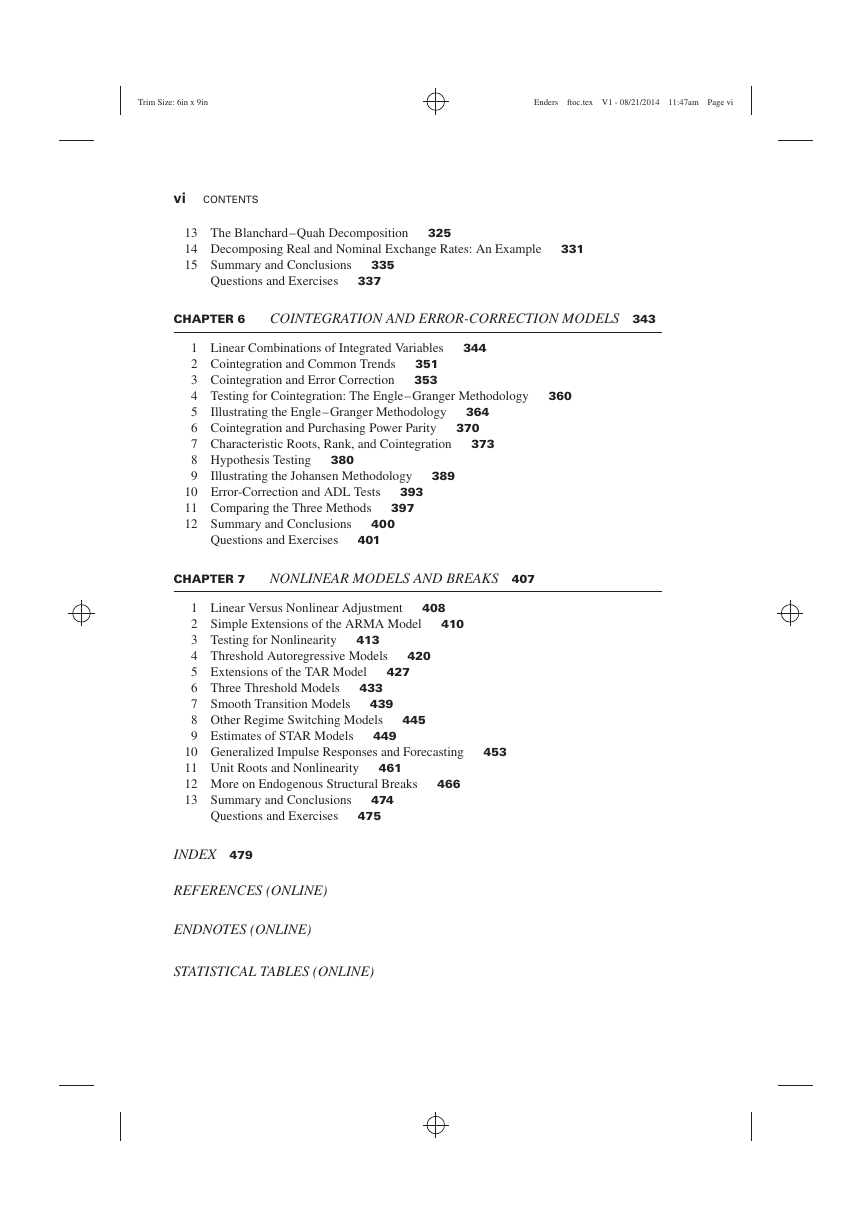








 2023年江西萍乡中考道德与法治真题及答案.doc
2023年江西萍乡中考道德与法治真题及答案.doc 2012年重庆南川中考生物真题及答案.doc
2012年重庆南川中考生物真题及答案.doc 2013年江西师范大学地理学综合及文艺理论基础考研真题.doc
2013年江西师范大学地理学综合及文艺理论基础考研真题.doc 2020年四川甘孜小升初语文真题及答案I卷.doc
2020年四川甘孜小升初语文真题及答案I卷.doc 2020年注册岩土工程师专业基础考试真题及答案.doc
2020年注册岩土工程师专业基础考试真题及答案.doc 2023-2024学年福建省厦门市九年级上学期数学月考试题及答案.doc
2023-2024学年福建省厦门市九年级上学期数学月考试题及答案.doc 2021-2022学年辽宁省沈阳市大东区九年级上学期语文期末试题及答案.doc
2021-2022学年辽宁省沈阳市大东区九年级上学期语文期末试题及答案.doc 2022-2023学年北京东城区初三第一学期物理期末试卷及答案.doc
2022-2023学年北京东城区初三第一学期物理期末试卷及答案.doc 2018上半年江西教师资格初中地理学科知识与教学能力真题及答案.doc
2018上半年江西教师资格初中地理学科知识与教学能力真题及答案.doc 2012年河北国家公务员申论考试真题及答案-省级.doc
2012年河北国家公务员申论考试真题及答案-省级.doc 2020-2021学年江苏省扬州市江都区邵樊片九年级上学期数学第一次质量检测试题及答案.doc
2020-2021学年江苏省扬州市江都区邵樊片九年级上学期数学第一次质量检测试题及答案.doc 2022下半年黑龙江教师资格证中学综合素质真题及答案.doc
2022下半年黑龙江教师资格证中学综合素质真题及答案.doc